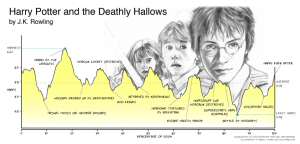It had to happen. A few years ago scientists analyzed more than 1,700 stories from classics like Romeo and Juliet to modern tales like Harry Potter and identified six core plots that form the building blocks of all complex narratives.
Okay, now bear with me. Things get rather technical at this point. But please read on because at the end you will be treated to a hilarious and wonderful (and short) video lecture by the late Kurt Vonnegut who explains “the shapes of stories.”
Here goes:
Using computers, researchers at the University of Vermont’s Computational Story Lab fed words linked to positive or negative emotion from the 1,700 stories to reveal an underlying set of story arcs. An emotional arc is similar to a plot-building block that tells a story by generating an emotional response from the reader. For example, ‘man falls into hole, man gets out of hole’ or one of the most well-known, ‘boy meets girl, boy loses girl, boy gets girl’.
To conduct the study, researchers used sentiment analysis, which is the idea that words have both positive and emotional impacts, to map the emotional arcs.

Words can be measured by the emotional valence of text and how it changes from moment to moment.
The team then analyzed the emotional polarity of ‘word windows’ and slid these windows through the text to create a picture of how the emotional valence changes.
This task was performed on fictional works taken from the Project Gutenberg website that had been downloaded more than 150 times each.
Still with me? Good.
So just what are the six arcs these academic mavens came up with?
Here they are:
- Fall-rise-fall: ‘Oedipus Rex’, ‘The Wonder Book of Bible Stories’, ‘A Hero of Our Time’ and ‘The Serpent River’.
- Rise-fall: ‘Stories from Hans Christian Andersen’, ‘The Rome Express’, ‘How to Read Human Nature’ and ‘The Yoga Sutras of Patanjali’.
- Fall-rise: ‘The Magic of Oz’, ‘Teddy Bears’, ‘The Autobiography of St. Ignatius’ and ‘Typhoon’.
- Steady fall: ‘Romeo and Juliet’, ‘The House of the Vampire’, ‘Savrola’ and ‘The Dance’.
- Steady rise:‘Alice’s Adventures Underground’, ‘Dream’, ‘The Ballad of Reading Gaol’ and ‘The Human Comedy’.
- Rise-fall-rise: ‘Cinderella’, ‘A Christmas Carol’, ‘Sophist’ and ‘The Consolation of Philosophy.’
Spoiler Alert! (The most popular stories were found to follow the ‘fall-rise-fall’ and ‘rise-fall’ arcs).
“For each of these six core emotional arcs, we examined the closest characteristic stories in publication today and found that particular emotional arcs enjoy greater success, as measured by downloads,” the study said.
The team also dove into the seven-book series of Harry Potter, as it may seem these stories would have multiple plots. But, the entire series can be classified as ‘Rag to riches’ and ‘Kill the monster’ story.

Okay, here comes some more technical speak from the study. Bear with me.
The most popular stories, the study found, are those that follow Icarus (rise-fall) and Oedipus (fall-rise-fall) arcs and stories that follow more complex arcs, which use the basic building blocks in sequence. Researchers also said that the most popular arcs are those that involved two sequential “man-in-hole” arcs and a “Cinderella” arc followed by a tragedy. There are two stories that genuinely support the “Rags to riches” plot mode. They are ‘Alice’s Under Ground’ and ‘Dreams.’
And among the most categorical tragedies, the plot that is a steady fall, are ‘Man in a hole, ‘Romeo and Juliet’ and ‘The House of the Vampire.’
Now for a few of my observations. I suspect not one of these researchers has ever written a novel. For one thing, I can’t imagine sitting down to write a novel and then deciding which “emotional arc” my story will follow.
Writing is not science. Notice I didn’t say “rocket science.” As much as some might like to think so, there are no tried and true formulas that you can feed into a computer in order to produce a compelling book. Writing is more like wringing water out of a wet rag. You squeeze your brain until it is dry of all plots, characters, and dialogue and then you toss your story out there for the hoi polloi to criticize and perchance (one hopes) to purchase and read.
Then you move on to the next story. You let your brain fill up with ideas and then you squeeze it dry once again. How often one does this depends on how durable your brain is.
So far, my brain is cooperating.
——————————————————————————————————————-
Click on the link below for Kurt Vonnegut’s “The Shapes of Stories.” You won’t be sorry.
https://www.youtube.com/watch?v=oP3c1h8v2ZQ


Right on about the video. Very entertaining. I have to guess that the computer analysis of the storylines was funded by a federal grant to give one or more grad students Doctorates. Seems most of those, nothing personal, are based on analyses of material with no practical application.
Ron, I believe all stories fall into one of two categories—Hero-Takes-a-Journey or Stranger-Comes-to-Town. Think The Odyssey and The Iliad. You can substitute any subsequent stories. Prototypically, think of the point of view of a sperm and an ovum. Billy Battles is a (fairly) modern-day Odysseus.
Hmm. Never thought of Billy as a modern day Ulysses. But why not?